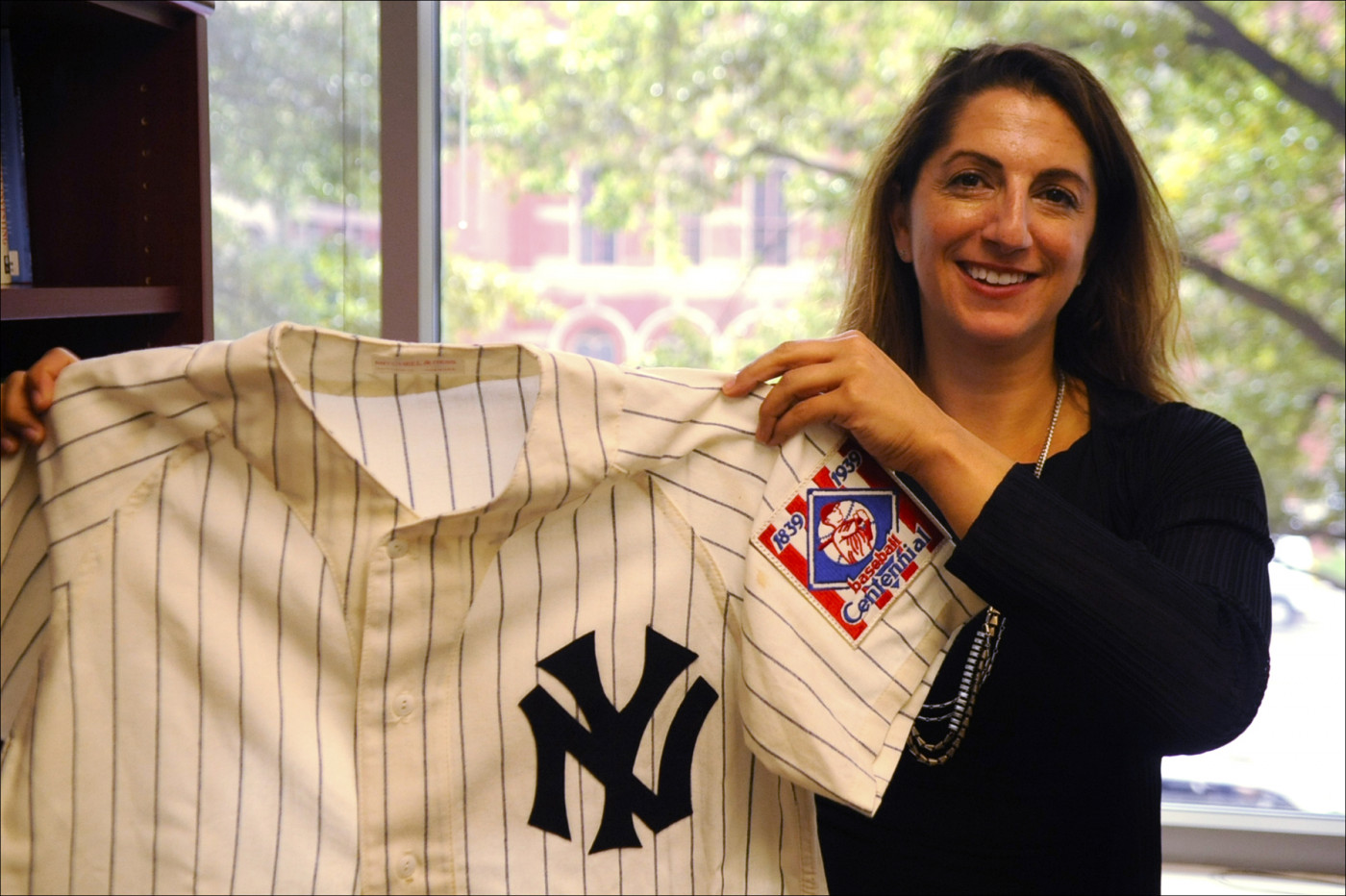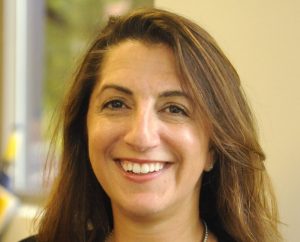ALS Association’s Incoming CEO Urges Insurers to Expand Narrow Coverage of Radicava

Calaneet Balas, executive vice president of strategy at the ALS Association in Washington, D.C. (Photo by Larry Luxner)
WASHINGTON — Visitors to the ALS Association’s Washington, D.C., headquarters can’t help but notice the silver baseball bat sitting in a glass display case at the entrance.
An inscription says the Louisville Slugger was presented in 1989 to Rodney L. Houts, the nonprofit group’s first president and CEO, to mark the 50th anniversary of both the National Baseball Hall of Fame in Cooperstown, New York, and Lou Gehrig’s retirement from the sport that dominated his life.
Over the years, baseball has come to symbolize amyotrophic lateral sclerosis (ALS), though the ALS Association no longer officially refers to the illness as “Lou Gehrig’s disease.” That’s simply because many younger people have never heard of the legendary New York Yankees first baseman, who died in 1941 at the age of 37.
Today, an estimated 15,000 Americans have ALS, according to the Centers for Disease Control and Prevention. The incurable neuromuscular disease, which strikes about one in every 400 people over the course of a lifetime, is more prevalent among whites, males and people in their 50s and 60s — especially among former professional athletes and those who served in the military.
Calaneet Balas, who’s replacing Barbara Newhouse as president and CEO of the influential association, recently talked to ALS News Today about the frustrations currently facing ALS patients and their families.
Topping that list is the difficulty in getting insurers to cover Radicava (edaravone), a recently approved ALS therapy developed by Japan’s Mitsubishi Tanabe Pharma that doesn’t reverse the disease but has been shown to slow its progression.
In an hour-long interview, Balas also discussed urgent legislative priorities ranging from eliminating the five-month waiting period for Social Security disability insurance and Medicare to preserving the Pentagon’s 35-year-old medical research program.
“I don’t think anyone’s taking anything for granted these days. In this current climate, you have to keep your eye on everything,” said Balas, who assumes leadership of the association after serving since June 2016 as executive vice president of strategy.
Access to Radicava among Balas’ top concerns
“Insurance is by far one of the biggest issues we’re dealing with, but this is to be expected,” she said of Radicava, a free radical scavenger therapy that must be delivered intravenously. It costs about $1,100 per infusion (not including the infusion service itself) administered in intensive 28-day cycles. That translates to roughly $146,000 a year.
“It’s an expensive drug, this is a rare disease, and the way it came to market was pretty unusual — through a clinical trial in Japan,” Balas told us. “Also, the study used a fairly small population, so there’s mixed reaction from the professional field. I know physicians who are not in favor of this treatment. They’re not sold on the data.”
Balas was referring to a pivotal placebo-controlled Phase 3 trial of 137 Japanese ALS patients (MCI186-19), in which the therapy led to a 33 percent drop in the rate of patients’ decline in physical function. An extension of that trial showed it also significantly slowed the progression of ALS.
In August 2016, the U.S. Food and Drug Administration (FDA) — citing the urgent unmet needs of ALS patients — accepted an application from the developer’s U.S. subsidiary, MT Pharma America, without insisting the results be confirmed in a trial in the United States. On May 5, 2017, the FDA announced Radicava’s approval as the first new ALS treatment since it green-lighted Sanofi’s Rilutek (riluzole) back in 1995.
To date, about 2,500 ALS patients have requested the therapy — yet only 500 are actually receiving it, according to Balas. The treatment starts with 14 consecutive days of therapy, followed by a two-week drug-free period. Patients then get the infusion during 10 of the next 14 days, followed by another two weeks without the drug.
Patients who qualify receive 60 mg of Radicava per treatment, and each infusion takes 60 minutes.
“If 2,500 people and their physicians think this is a treatment they should try, then they should have access to that treatment,” she said. “Most of the patients I’ve talked to want to try this drug. It gives them hope.”
Narrow inclusion criteria for Radicava coverage
The problem is that insurance companies have made it very difficult for patients to actually get the drug covered under their health plans, said Balas, who was CEO of the Ovarian Cancer National Alliance before joining the ALS Association.
“What they’ve done, for the most part, is to use the inclusion criteria for the clinical trial as criteria for qualifying [patients] for the drug, which is incredibly narrow,” she complained.
In order to qualify, ALS patients had to score a certain number of points on the Functional Rating Scale that looks at 12 measures of functionality. To be included for the study, patients needed at least a score of 2 on a scale of 0-4.
“So if you scored less than 2 in any one of the 12 areas, you would not qualify for the study — and they’ve used that same criteria in qualifying for insurance coverage,” she said. This, Balas said, easily excludes 75 to 80 percent of all ALS patients.
For example, Balas knows a Texas man with ALS who can walk and eat, but not speak.
“That factor, in and of itself, would have disqualified him,” she said. “The way the criteria is written doesn’t really make sense, because you want to keep his functionality as long as possible. Just because he can’t speak doesn’t mean he doesn’t have quality of life in all these other areas.”
She added: “Another ALS patient in Massachusetts who I adore can walk, talk and eat. He’s lost some functionality of his hands, and his forced vital capacity is 76 percent, but because that was less than 80 percent, it disqualified him. I don’t think the insurance companies are educated about the disease and what these qualifying factors mean, and what two points on a scale means to somebody.”
To rectify the situation, Balas said “we’ve been reaching out to insurance companies directly,” though she wouldn’t identify them.
“I’ve had conversations with a couple of them, and we’ve had a couple of successes in getting some insurance companies to rethink their criteria,” she said. “We’ve also encouraged them to look at the VA’s criteria. The FDA label was wide and the Veterans Administration is not quite that wide. It’s pretty reasonable.”
Association has ‘strong voice’ on Capitol Hill
This last point is especially important to the ALS community, she said, because people who have served in the military — regardless of what country they represented or what they did — are twice as likely to develop ALS as those who’ve never served. So are professional athletes.
“I’ve said for months to anybody who would listen to me that this drug shows potentially good increments for people. The FDA decided that this drug has a good safety profile and track record in Japan for over 20 years,” she told us. “Our patients have said, ‘if you think something might work, don’t leave it on the shelf.’”
Radicava’s success contrasts with the recent failure of tirasemtiv, about which Balas had expressed “cautious optimism.” That therapy’s developer, Cytokinetics, pulled the plug on its fast skeletal muscle troponin activator on Nov. 21 after the drug failed to meet either the primary endpoint or any of the secondary endpoints of its Phase 3 clinical trial.
On its website, the association said it was saddened by the news but “grateful that Cytokinetics has already expressed its commitment to finding new therapies for people with ALS, and hopeful that its next treatment, which is currently in clinical trials, will be successful.”
With 39 chapters nationwide, the ALS Association employs about 45 people — half of them in the Washington office. It raises just over $75 million per year. Its now-ubiquitous Ice Bucket Challenge, inspired in 2014 by Anthony Senerchia, who died Nov. 25, generated more than $200 million in donations toward research into ALS treatments.
“We have a strong voice here, and a good reputation. We’re on the Hill all the time, and we work very closely with many lawmakers,” said Balas, citing two Democrats — Sen. Bill Nelson of Florida and Rep. Seth Moulton of Massachusetts — as longtime supporters of the cause.
Waiving SSDI delays, saving Pentagon research program
Insurance issues aren’t the only challenge facing the ALS Association as Congress considers monumental changes to the nation’s healthcare system.
One of its biggest concerns is the five-month waiting period for Social Security Disability Insurance (SSDI). Under the proposed ALS Disability Insurance Access Act of 2017, those with ALS would immediately begin receiving SSDI, which in turns qualifies them to get Medicare assistance as well.
“We’re trying to get the five-month waiting period for Social Security waived,” she said. “Because this disease moves so fast, even that five-month period can be significant. Some people have passed away before they received any of their benefits.”
The ALS Association is also worried about threats to the Pentagon’s Congressionally Directed Medical Research Program.
Since its establishment in 1992, the program has received $11.9 billion in taxpayer funds for research on medical projects — especially projects that benefit veterans, retirees and military spouses — that other agencies and private investors might be unwilling to fund.
Yet four provisions in the Senate’s fiscal 2018 National Defense Authorization Act seek to effectively eliminate the program “by burying it in onerous and unnecessary requirements and excessive amounts of red tape,” according to a letter drafted by Sen. Richard J. Durban (D-Illinois) and Sen. Roy Blunt (R-Missouri) protesting the decision.
The bipartisan letter, endorsed by 51 other lawmakers, urges Sen. John McCain (R-Arizona), chairman of the Senate Armed Services Committee, to keep the program alive.
“John McCain has been adamantly opposed to this program for years. It’s been there for decades, and he’s been trying to slash it out of the budget,” Balas said. “But the program includes $10 million of research funds for ALS and we don’t want to see that gone.”








